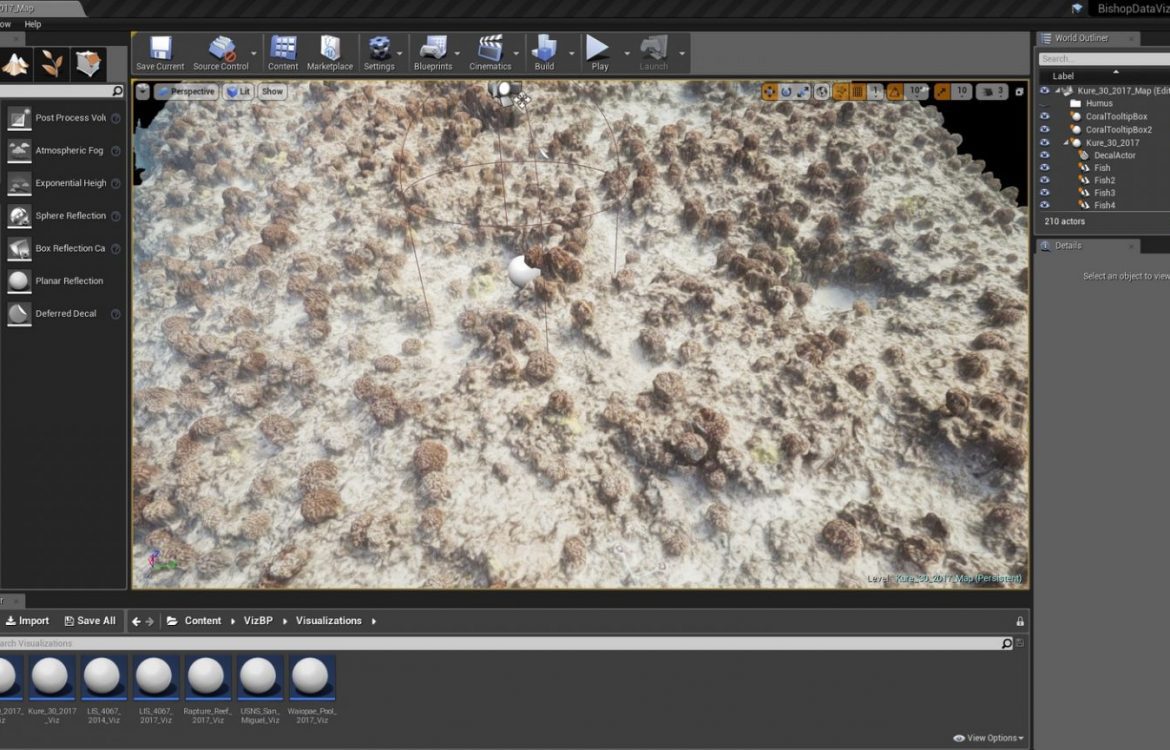
UH Hilo, UH Manoa undergrads team awarded for Hawaiian coral reefs VR app
A team of undergraduate students from the University of Hawai`i at Hilo Computer Science Department and the University of Hawai`i at Manoa College of Engineering was recently awarded with the Best Visualization Showcase Award for the upcoming 2020 Practice and Experience in Advanced Research Computing (PEARC) Conference for its work on integrating three-dimensional models of Hawaiian coral reefs into an immersive virtual reality platform.
“Exploration of Coral Reefs in Hawai`i through Virtual Reality: Hawaiian Coral Reef Museum VR” showcases models that were generated from high-resolution surveys at long-term monitoring sites throughout the Papahānaumokuākea Marine National Monument. Thousands of images of coral reef habitats were collected by UH Hilo Assistant Professor of Marine Science Dr. John Burns and his research team during ship-based research expeditions led by the National Oceanic and Atmospheric Association. The images were then processed by the UH Hilo Multiscale Environmental Graphical Analysis (MEGA) Lab using structure-from-motion photogrammetry technology to create high-resolution 3D reconstructions of each coral reef study plot. These models form the foundation of the immersive virtual reality experience.
“One of the primary objectives was to create virtual outreach products to showcase these incredible and unique products to public audiences around the globe,” said Francis Cristobal, UH Hilo Faculty Specialist, Computer Science, who spearheaded the two-year project.
“When the application starts, the user is brought into a Coral Reef Museum filled with a curated selection of coral reefs. The user then picks a reef to explore and is transported to a life-sized 3D model of it,” Cristobal explained. “From there, the user can resize, reposition or fly through a 3D model, offering a wide range of interactivity. This human-centered design is particularly an effective platform for researchers, instructors, and the general public.”
These reconstructions also allow researchers to examine how the coral reefs change over time and respond to stressors associated with climate change.
“The models provide an excellent public outreach tool as audiences can get a first-hand realistic view of what these isolated and protected coral reefs look like,” Cristobal said.
Team members include:
· Briana Noll, UH Hilo Computer Science (graduated Spring 2020)
· Nickolas Rosenberg UH Hilo Computer Science (graduated Spring 2020)
· Drew Gotshalk, UH Hilo Computer Science (graduated Spring 2020)
· Alec Goodson, UH Hilo Computer Science (graduated Spring 2020)
· Kailey Pascoe, UH Hilo MEGA lab
· Alexandra Runyan, UH Hilo Marine Science
· Michael Dodge II, UH Manoa 4th year, Electrical Engineering
· Jared McLean-UH CyberInfrastructure
· Ryan Theriot, UH Manoa LAVA
· John Burns, UH Hilo Marine Science and MEGA
· Joseph Sanchez, UH Hilo Edwin Mookini Library
· Francis Cristobal, UH Hilo Computer Science
The project is a collaboration of UH Hilo Computer Science, the UH Hilo Multiscale Environmental Graphical Analysis (MEGA) Lab, UH Manoa Laboratory of Advanced Visualization and Applications (LAVA), `Ike Wai Data Science initiative, and the UH Hilo Edwin Mookini Library. The project was funded by UH System Academy of Creative Media.
The virtual museum will be showcased at the Mokupapapa Discovery Center in Hilo, Hawai`i and will be a travelling exhibit. It will also be presented at the Hawai`i State Legislature.
The PEARC20 takes place online July 26 – 30, 2020 and will explore the current concepts of advanced research computing including modeling, simulation, and data-intensive computing.
